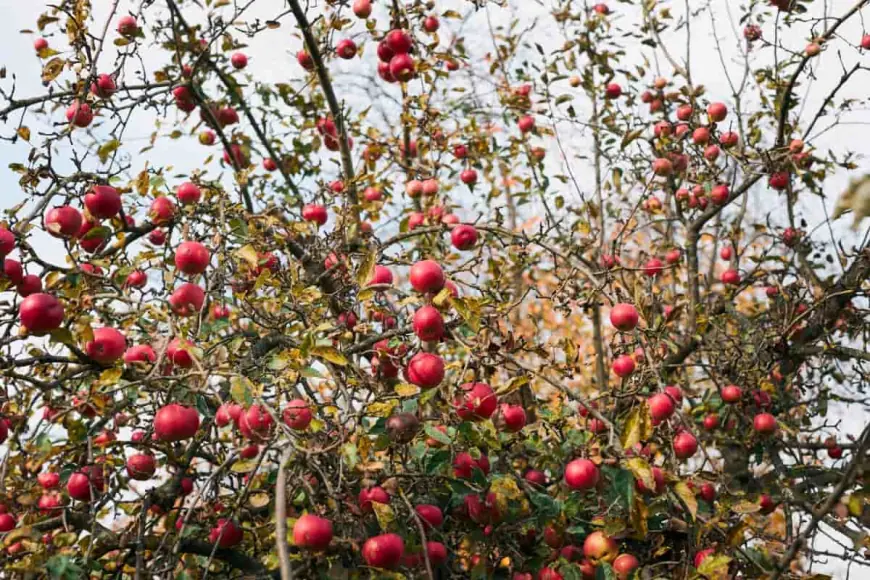Beginner’s Guide to Apple Cultivation: Tips, Climate & Care
Apple cultivation has become a popular farming choice for many Indian farmers, especially in the hilly regions

Apple cultivation has become a popular farming choice for many Indian farmers, especially in the hilly regions. Apples are loved for their sweet taste, good looks, and health benefits. As the demand for apples grows in cities and villages alike, many farmers are now interested in growing apples for better profits. But to begin apple farming successfully, you must understand the basics—climate, soil, variety, care, and the right tools.
8 points to Understand Apple Farming
Apple farming requires the right climate, soil, and proper care to ensure healthy trees and high-quality fruit.
Best Climate Conditions
Apples grow best in cool climates where the temperature remains between 15 to 24 degrees Celsius. These trees need a chilling period in winter. This means the trees must stay in cold weather—below 7°C—for about 1000 to 1500 hours each year. This rest period helps apple trees flower properly in the next season. If apples are grown in areas that are too hot or do not get enough winter chill, the fruit quality will be poor and the production will be low. That’s why apple farming is mostly seen in Jammu & Kashmir, Himachal Pradesh, and Uttarakhand.
Soil That Supports Healthy Apple Trees
Along with the right weather, apple trees also need the right soil. Loamy soil that is soft, fertile, and full of organic matter is the best for growing apples. The soil should not hold water for long, because standing water can rot the roots. A slight slope in the field helps water drain out easily. The pH level of the soil should be between 5.5 and 6.5. Before planting trees, farmers must test the soil. This helps them add the right amount of compost, cow dung, or nutrients if the soil is weak. A well-prepared field gives the apple saplings a good start.
Choosing the Right Apple Variety
There are many apple types available in India. Some are sweet and red, while others are green or golden in color. Red Delicious, Royal Delicious, and Golden Delicious are common varieties grown in India. McIntosh and Granny Smith are also famous for their taste and use in juices or cooking. While choosing the variety, farmers should think about the climate of their area and what kind of apples are in demand in the local market. Local experts or experienced farmers can help beginners decide the best variety for their orchard.
How and When to Plant Apple Trees
The best time to plant apple saplings is during winter, between December and February, when the trees are at rest. Apple trees are planted using grafted saplings, not seeds, to ensure fast and healthy growth. Farmers must dig square pits of around one meter on each side. They should mix compost or well-rotted manure in the pit and plant the sapling carefully. It is important to leave enough space between trees, usually 15 to 20 feet, so that each tree gets sunlight, air, and room to grow.
Caring for Your Apple Orchard
Apple trees need love and care throughout the year. Young trees need water regularly, especially in the summer months. As they grow older, the trees need less frequent watering. However, farmers must make sure the soil stays moist and not dry. Pruning is also very important in apple farming. Cutting off weak or dry branches during the winter helps the tree grow stronger branches and bear more fruit. Pruning also improves air movement and sunlight between branches, which keeps the tree healthy and reduces pests.
Apple trees also need nutrients. Farmers should apply compost or organic manure at least twice a year. Sometimes, the trees may need extra help from fertilizers like nitrogen, phosphorus, and potassium. This depends on the tree’s age and the soil’s condition. If you are not sure, it is always good to ask an agriculture officer nearby. Keeping the orchard clean, checking the trees for pests, and spraying medicines when needed are also part of good orchard care.
Harvesting and Storing Apples
Apple trees usually start giving fruits after three to five years. The harvesting time depends on the variety and the climate, but in most parts of India, apples are ready between August and October. When the apples change color and become firm, they are ready to pick. Harvesting should be done with care so that the fruits are not bruised or damaged. Apples should be kept in clean baskets and stored in cool, dry places. In modern times, cold storage helps farmers store apples for a longer time and sell them when prices are high.
Machines That Make Apple Farming Easier
In today’s farming world, machines help farmers save time and energy. Apple farming needs work at every stage—from digging and planting to spraying and carrying apples. A mini farm tractor can be very helpful for farmers with small orchards or those working on hilly land. These small tractors can easily move between tree rows and do many tasks like ploughing, spraying, and carrying loads. Many farmers today are searching for tools like this that are easy to use and affordable. If you are comparing models, checking the latest Indo Farm Mini Tractor Price can help you decide which machine fits your needs and budget. These tractors are strong and designed for Indian farms.
Selling Your Apples in the Market
After the apples are harvested and sorted, the next step is to sell them. Farmers can sell apples in local mandis, directly to wholesalers, in fruit shops, or even online. Many farmers also tie up with juice makers and processing companies. It is a good idea to pack apples properly and keep them clean to get a better price. If your apples are fresh, chemical-free, and tasty, they will always find good buyers. Over time, farmers can also build their own brand name by selling directly to consumers in nearby towns or cities.
Conclusion
Apple farming is not just for the big growers anymore. With better knowledge, support from local agriculture departments, and use of the right tools, even small farmers can start apple cultivation and make it successful. It is important to understand the land, weather, and plant needs before starting. Start small, learn with time, and slowly expand. Patience, care, and smart farming methods can help any farmer grow a healthy apple orchard. If you are thinking of beginning your journey in fruit farming, apple cultivation is a great way to get started and grow.
What's Your Reaction?
 Like
0
Like
0
 Dislike
0
Dislike
0
 Love
0
Love
0
 Funny
0
Funny
0
 Angry
0
Angry
0
 Sad
0
Sad
0
 Wow
0
Wow
0



















































